Philip C. Stead Visits 7-Imp to Share
Where a Story Comes From…
Or: How a Toad Named Vernon
Ended Up Sailing a Teacup into the Great Unknown
 May 3rd, 2012 by jules
May 3rd, 2012 by jules

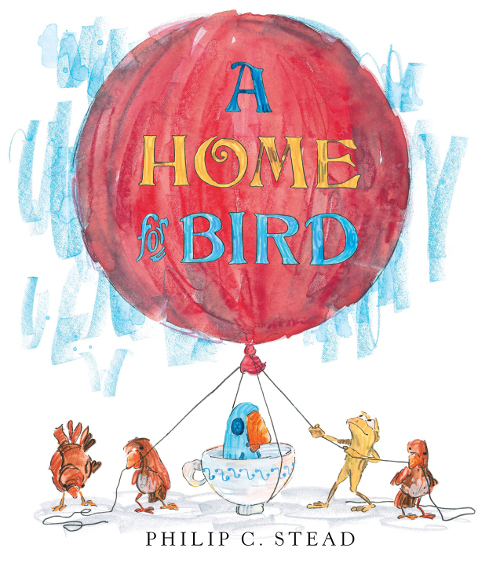
You all know I’m a ginormous picture book addict, and I tell you what: Author/illustrator Philip C. Stead knows how to send just the right content to make this blogger happy. I’ve been trying to convince him to come have one of my standard breakfast interviews for years now, but (lucky for me and my imp readers) he likes to do things differently at pretty much all times and sends me the kind of words and images you see in today’s post (and the goodness he sent last year) instead.
I am very good with this.
And why is that? Well, take today’s post: Phil gets very detailed about the story behind his new picture book, A Home for Bird, to be released in June by Neal Porter/Roaring Brook — the story’s history and how it got to where it is today. He also shares lots of sketches and even pictures of specifically what he uses to make his art. And this time he’s done something different from collage (but he tells you more about that below). Yes, if you’re a fellow picture book fan, his thoughtful words and images will make you happy today, so grab a cup of coffee and won’t you sit for a spell?
I don’t want to ramble here, as I’d like to get straight to Phil’s words and images. A quick note on the book, though:
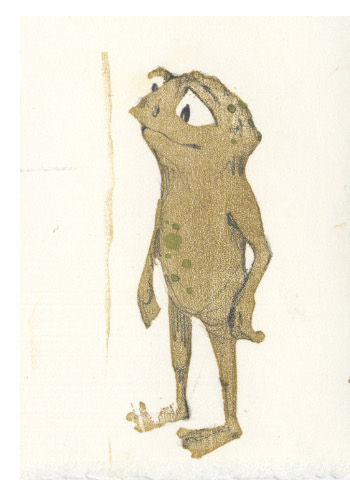 Phil tells you enough about it below for you to get a sense of the storyline, so I won’t waste your time with that. But I do have to say that this book is a thing of beauty and that I highly recommend you find a copy for your own hands, by hook or by crook, in June. My favorite parts? The sunny palette; the subtle humor (I also highly recommend slow readings, as well as repeated ones); the movement that Phil gets in the book’s lines (even in stillness), as well as the textures he pulls off with crayon and gouache; and the surprises for fans of his previous books. (He mentions some below, but I’ll add that you can also spot Frederick in one spread.)
Phil tells you enough about it below for you to get a sense of the storyline, so I won’t waste your time with that. But I do have to say that this book is a thing of beauty and that I highly recommend you find a copy for your own hands, by hook or by crook, in June. My favorite parts? The sunny palette; the subtle humor (I also highly recommend slow readings, as well as repeated ones); the movement that Phil gets in the book’s lines (even in stillness), as well as the textures he pulls off with crayon and gouache; and the surprises for fans of his previous books. (He mentions some below, but I’ll add that you can also spot Frederick in one spread.)
Best of all, though? The pulsing heart at the core of this story, told with a beautiful economy: This is about one determined, thoughtful friend who not only doesn’t give up on his companion, but who also finds contentment in bringing happiness to another — and in helping his friend find his footing again (both literally and figuratively).
Wait. One more thing. Very best of all is something I touched upon last year when Phil visited. And that’s that Phil’s not afraid to color out of the lines (in more ways than one), and he’s not afraid of squeaks and wobbles and lines that aren’t perfect. In a world where publishing is capable of such high-gloss books (which often, to me, lack life), Phil—as I wrote last year—lets the raw materials shine and seems to be telling us that occasional (and intentional) smudges and speckles and exuberant, spontaneous lines and the all-around absence of glitz, gloss, and utter flawlessness are things that are not just allowed, but they’re also celebrated.
And the endpapers? They are not illustrated, but they are a simple, creamy and rich navy blue. I don’t know who made that choice, but they’re beautiful. (I just have to quickly throw that in. Am I crazy, or do we not often see such choices in endpapers these days — such rich, dark hues, that is?)
Thanks to Phil for visiting, and oh! Before we sit down with him, check out the trailer (with music composed and performed by Phil himself) …
Phil: So, where does a story come from anyway? I’ve been wondering that lately in the last few weeks before the publication of my new book, A Home for Bird. The story-making process for Bird was long (very long) and strange with many roadblocks, dead ends, and false starts along the way. Typically, when I finish a book I don’t like to return to it at all. I don’t even like to look at books I’ve written or illustrated, unless I absolutely have to. But A Home for Bird was such a strange, unpredictable process for me that I feel compelled now to take a look back.
If I try to pinpoint a moment when A Home for Bird really began, it was around the spring of 2006. We were living in Brooklyn at the time and one evening I sat down at the kitchen table and made a drawing in my sketchbook of a sad, little toad sitting on a telephone wire. I don’t know where this image came from. It just happened and I didn’t think much about it. I wish I could show you that first drawing, but it was lost somewhere along the way—probably during one of our five moves in four years. (Moving from home to home becomes an important theme in A Home for Bird later on.)
This little toad character stuck with me in the months that followed. I started to imagine where he lived — a cuckoo clock in the countryside:
I gave him possessions — a spool of thread (his favorite chair):
I put him into situations — sailing a teacup down the river on a moonlit night:
I made more and more of these images until a kind of story began to develop. It was only natural that a cuckoo bird would become a supporting character. I had them do things with each other, like fly a hot air balloon made from a teacup and scraps and cloth sewn together:
I made these drawings completely for myself. I had no intention of turning them into a publishable story.
Cuckoo clocks have been a recurring theme for me for a long time. A cuckoo clock plays a big role in my first book, Creamed Tuna Fish and Peas on Toast:
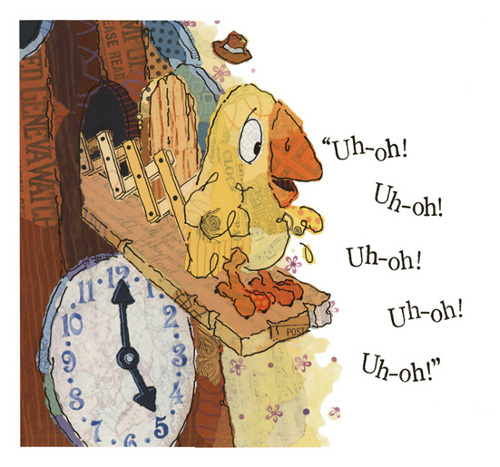
One shows up in the background of Jonathan and the Big Blue Boat too:

But why? When I was a kid my house was filled with clocks — grandfather clocks, cuckoo clocks, pocket watches kept under glass domes (Amos McGee carries a pocket watch), clocks with neon lights that light up on the hour and play “Hey, Jude.” There was even a mantel clock that, after 25 years of doing nothing but chiming the hours and half-hours, suddenly started chiming a Jewish folk song. Weird! The clocks I’ve known have had personalities. Which is why, I think, that clocks keep popping up in my books.
Okay, getting back to A Home for Bird…
Several months passed, and Erin and I moved out of New York City and into a cabin upstate in the Catskill wilderness. In some ways our new home was like the cuckoo clock I’d drawn, surrounded by mountains in the country with a river flowing by. It sounds idyllic, but the year spent in that house was memorable for its terribleness. Everything that could have gone wrong with that home did. It was cursed. I’ll spare you all the unpleasant details, but this image from Stanley Kubrick’s The Shining will give you a rough mental image of where we were living:

This image will represent me from that time period:
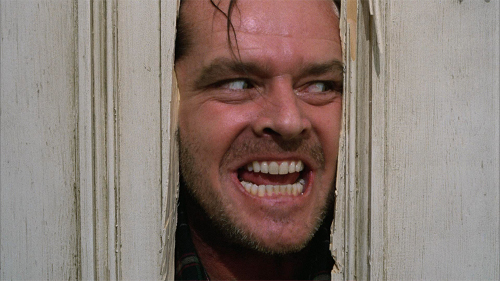
This one will represent Erin:
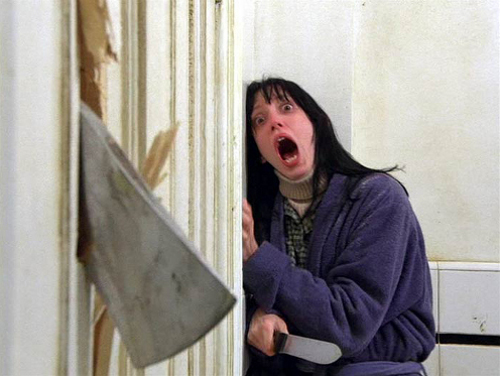
It was at this time that I started thinking about moving — and about bad homes as possible story themes. Like they say, write what you know!
In November 2007, Erin and I took a much needed vacation to Hawaii. Transoceanic flights are a great place to get some writing done. It was on that flight, mostly out of boredom, that I first jotted down a toad-related story idea. It was titled A Toad and a Teacup. Looking back now, these ideas bear almost no resemblance to the story that became A Home for Bird.
When the plane landed, we went back to our terrible home and I put away the story for what turned out to be about two whole years. I was finishing the art for Creamed Tuna Fish and Peas on Toast and, later, Jonathan and the Big Blue Boat. Erin was working on A Sick Day for Amos McGee. We moved in and out of two more homes during that time. At the start of 2010, it was time for me to begin a new story. The Toad and the Teacup was still hanging around in my brain cells, so I decided to explore it some more to see if it had a future. A have a lot of ideas that come and go. I think the best ideas are willing to stay and wait their turn.
Erin and I had been talking for a while about if and how we could make a book together. By “together” I mean actually making the art together, unlike Amos where I did the writing and Erin handled the art by herself. It would require that we find some kind of hybrid way of working. We began to experiment with some techniques. This was an early character and color study:
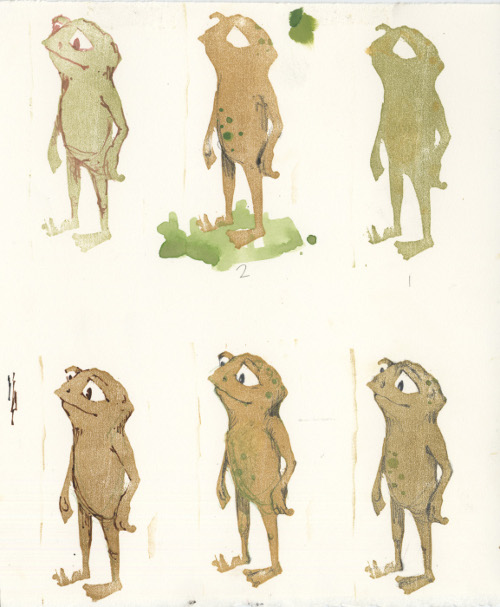
Erin and I worked on this together for several weeks. In the meantime, we tried to tighten up the story.
We did lots and lots of preliminary sketches. Unfortunately, the story wasn’t really very good. In fact, it was a mess. The artwork was kind of unimpressive, too. Eventually, we decided it wasn’t yet possible for us to mix our art styles without making the sum lesser than the individual parts. So, the story and artwork reverted back to me by default. Although the story was not quite right yet, I decided it was time to show our editor and art director at Roaring Brook Press, Neal and Jennifer. We tend to pitch ideas to them over lunch or coffee in a casual sort of way, so there’s not a lot of pressure to be perfect. The story we pitched went something like this: Vernon, a toad, lives in a cuckoo clock house by the river. One day a big storm damages the house. He and his upstairs neighbor, Bird, go on an adventure heading down the river in a teacup to look for a new home. Eventually they return home where they started, fix up the old house, and everyone lives happily ever after.
That is the simplified version. But in order to make the logic of the story work—why, for example, does Vernon live in a cuckoo clock by the river?—there had to be a number of subplots and digressions that in no way helped the overall flow of the story. Neal (our editor, in case you forgot), in his infinite wisdom, pointed this out to us right away. Normally, this would probably mean the end of a project but Neal and Jennifer, like Erin and I, seemed to have an immediate fondness for the story’s characters, even if the story itself was somewhat weak.
Oddly enough, I felt liberated to hear that my story stunk. It freed me up to think of new scenarios in which Vernon could meet Bird.
At first, I wasn’t sure why I chose the name Vernon. It wasn’t until much later that I realized that it wasn’t a random choice at all.
This is my great-grandpa Vernon:
(Click to enlarge)
Vernon worked at a Ford dealership in Detroit. We never met, but I’ve inherited a number of his things. He was an amateur electrician. This was his cabinet that he filled with interesting little electrical parts and knickknacks:
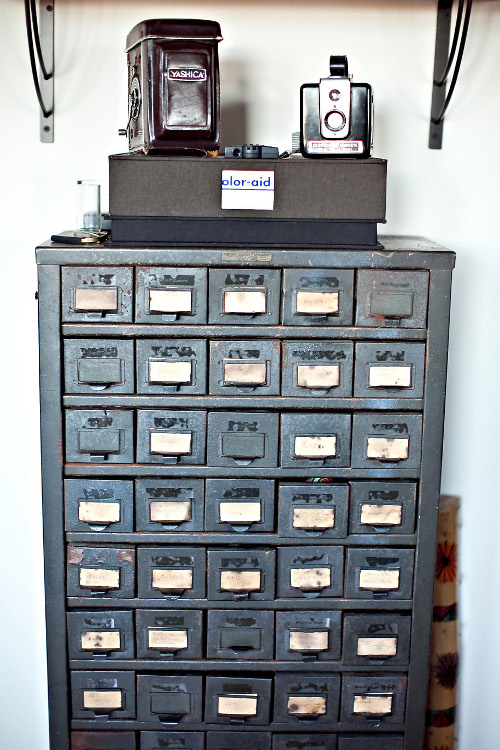
There are lots of great things inside:
Vernon (the toad) is a collector of interesting things, too. In fact, the first line of A Home for Bird is: “Vernon was out foraging for interesting things when he found Bird.”
One of the interesting things that Vernon (my great-grandpa, not the toad) collected during his lifetime was this cuckoo clock:
Vernon bought the clock at a pawnshop during the Depression, and today it hangs in my living room. So, without realizing it, my brain made a series of simple connections. Vernon –> Collector of Interesting Things –> Cuckoo Clock.
Okay, back to my story again…
Having moved, by now, five times in four years, moving was very much on my mind. The image of a ramshackle moving truck came to me one day.
That became the turning point — in that it gave me a more plausible premise: What if a cuckoo bird went flying off the back of a moving truck?
And what if a curious and kind little toad happened upon that cuckoo bird?
‘Are you okay?’ asked Vernon. Bird said nothing.
‘Are you lost?’ Bird said nothing. ‘You are welcome to join me,’ said Vernon.”
(Click to enlarge)
Suddenly everything fell into place. There were side characters:
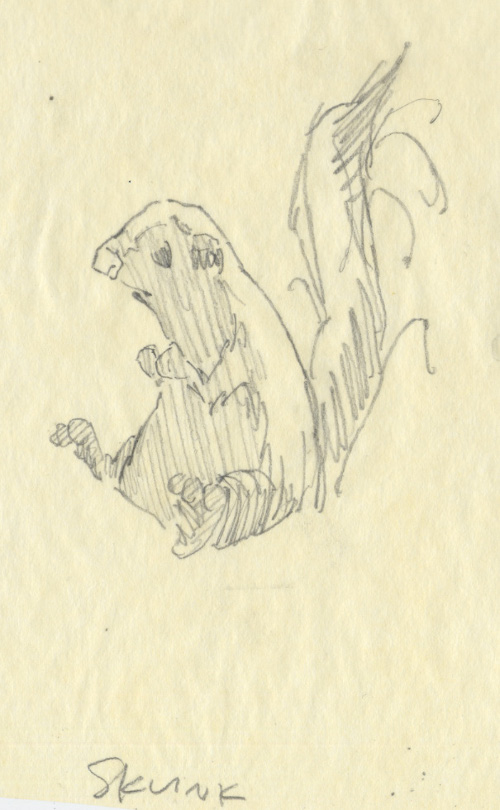
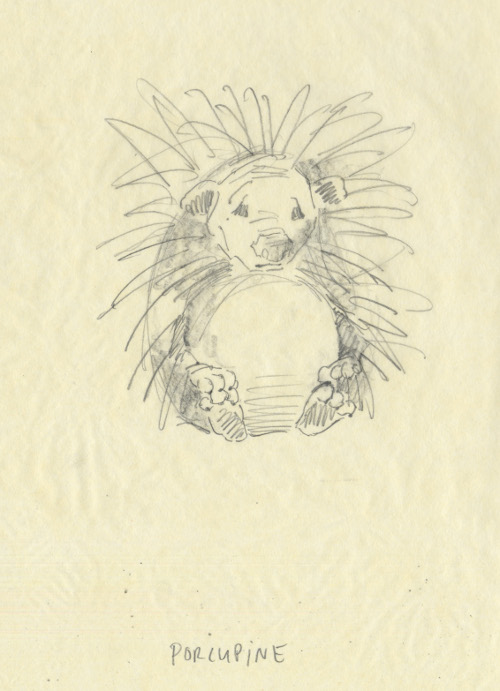

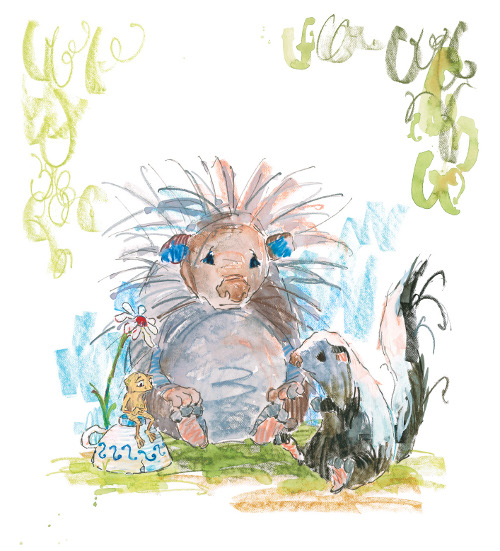
‘Perhaps he is lost,’ said Skunk. ‘Maybe he misses home,’ said Porcupine.”
‘Bird,’ said Vernon, ‘meet Skunk and Porcupine.’ Bird said nothing.
‘Bird is shy,’ said Vernon, ‘but also a very good listener.'”
(Click to enlarge)
A lot of the original story ideas fit into place too. Like, the teacup and the river:
(Click to enlarge)
And even the image of a toad sitting on a telephone wire:
(Click to enlarge)
Neal and I revised the story together several times, working to get the text just right. Of all the books I’ve done, A Home for Bird was the most collaborative from an editorial standpoint. There were more drafts of the story than I care to count.
It might not look like it, but this page actually represented a major breakthrough in the storytelling for me:
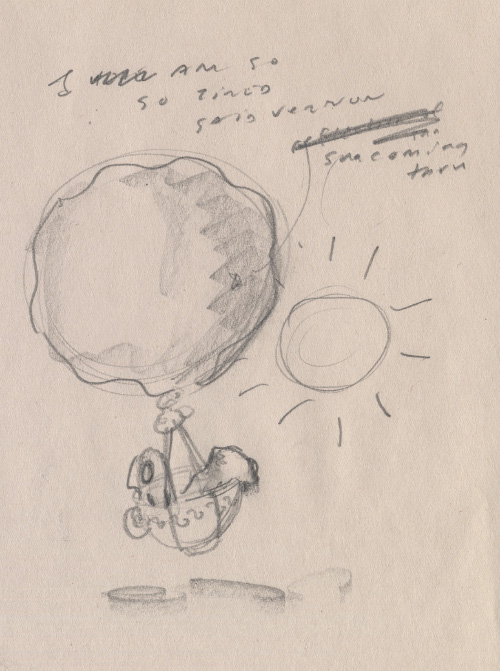
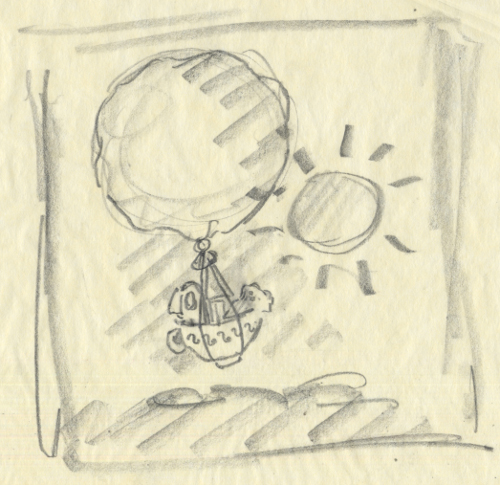
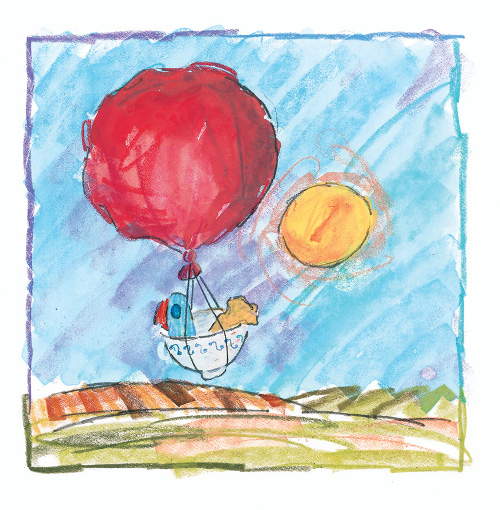
All that was left for me to do was to decide on an art style. My previous two books were done in collage, a very labor intensive, multilayered process. I love working that way, but the style just didn’t feel right for the characters or the setting in A Home for Bird. In the end, I settled on a style and materials that I was almost completely unfamiliar with…
…water-soluble crayon:
…and gouache:
This is a year’s worth of crayon shavings that I’m thinking about melting down into a single Crayon of Infinite Awesomeness:
I kicked myself many times over the next year for having made the decision to use these materials. Working with crayon might sound fun but, well, you can’t erase when you mess up. I’ve never had to tear up and throw away so much artwork. It is an odd and uncomfortable feeling to be learning how to use materials while working on a project that’s going to be published (not to mention reviewed and critiqued).
When a picture went well for me, I could finish in a single day, as opposed to one or two weeks for an individual collaged picture. My process was simple. It went like this: I did an under-drawing all in crayon…
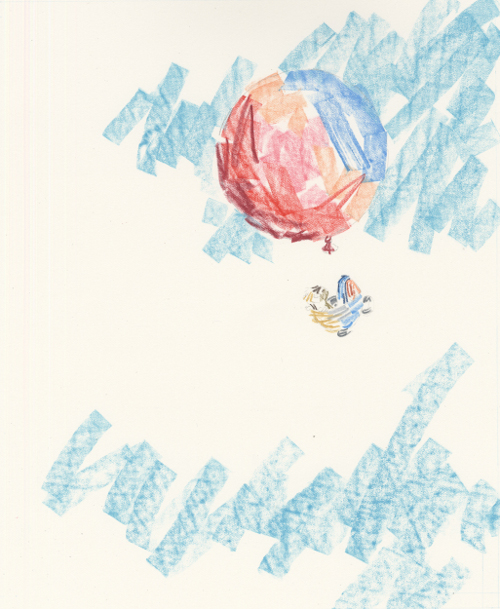
Then I painted over with gouache:
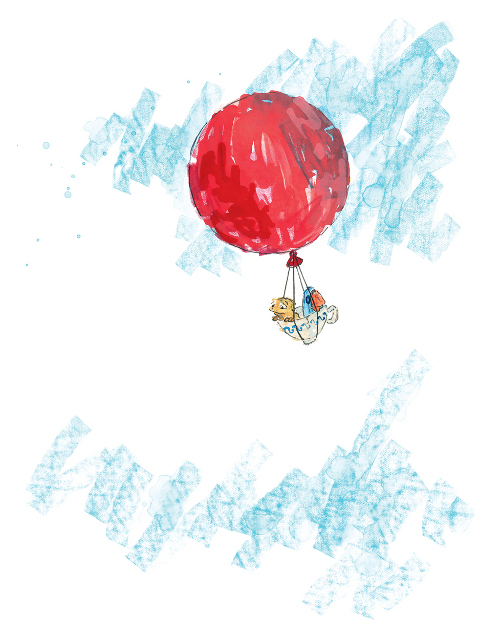
Bird said nothing. ‘Bird is very brave,’ thought Vernon.”
And that’s it.
I should have finished the book quickly, but because of all my mix-ups and failed attempts, it took me a whole year to finish the artwork. Eventually, though, I was ready to turn in the final art.
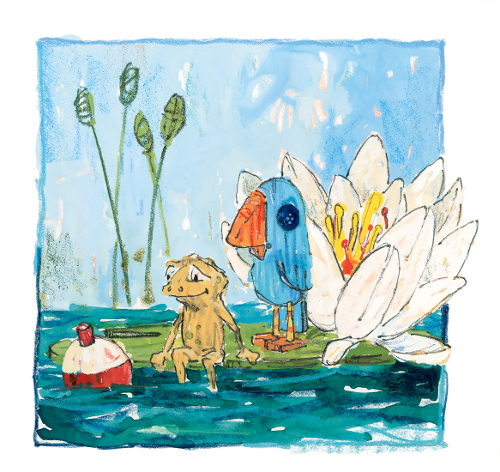
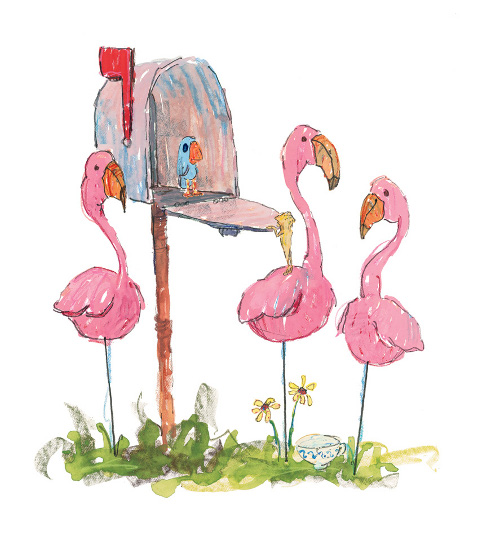
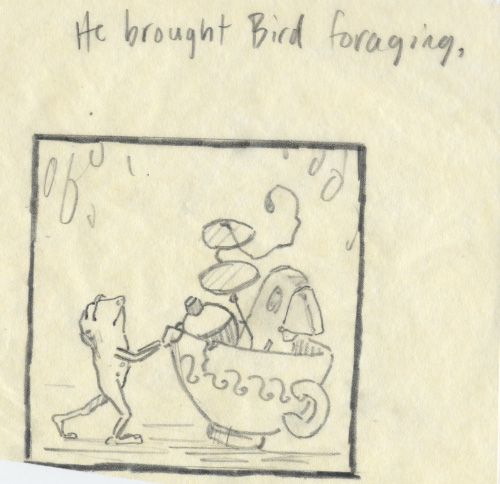
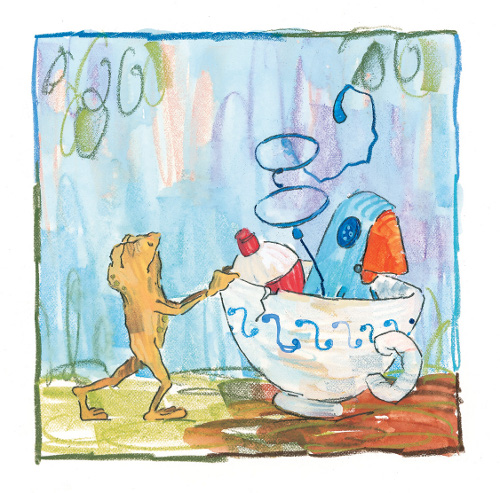
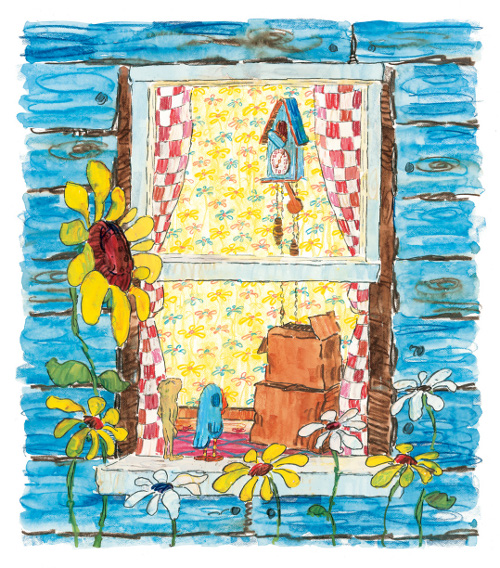

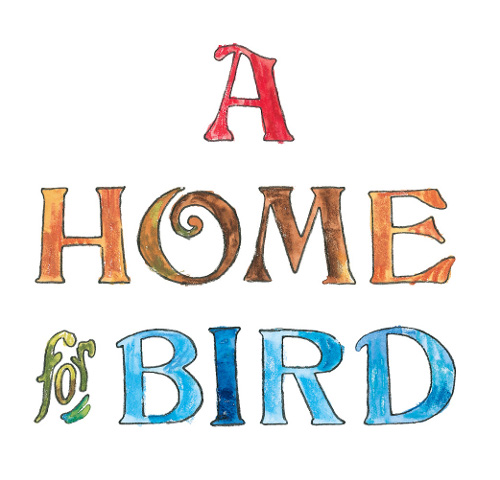
A Home for Bird will be released June 5th, 2012, more than six years since my first drawing of that sad, little toad sitting on a telephone wire.
So, where do stories come from? Really, I have no idea. Maybe all the stories I’ll ever write already exist, and it’s just up to me to discover the pieces and put them together. I’ve always been a collector, so that notion appeals me.
I collect my stories — sometimes it takes a long, long time.

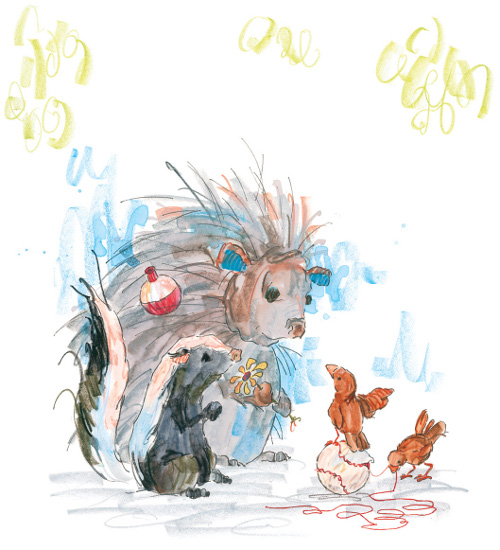
A HOME FOR BIRD. Copyright © 2012 by Philip C. Stead. Published by Neal Porter/Roaring Brook, New York. All images reproduced by permission of Philip C. Stead.
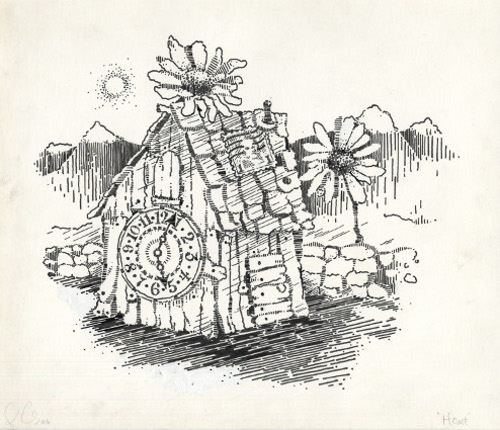
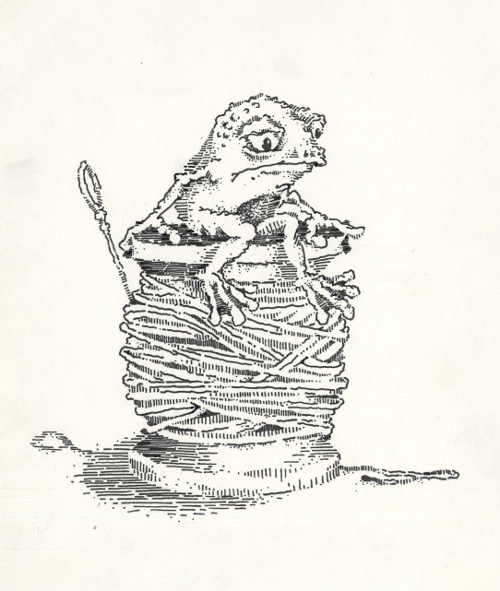


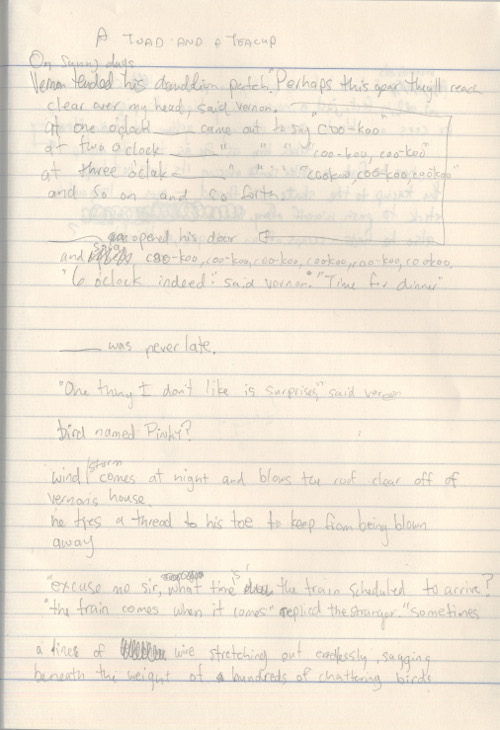

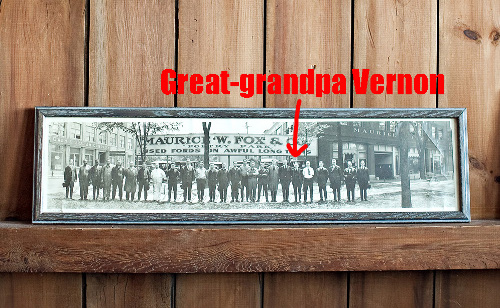
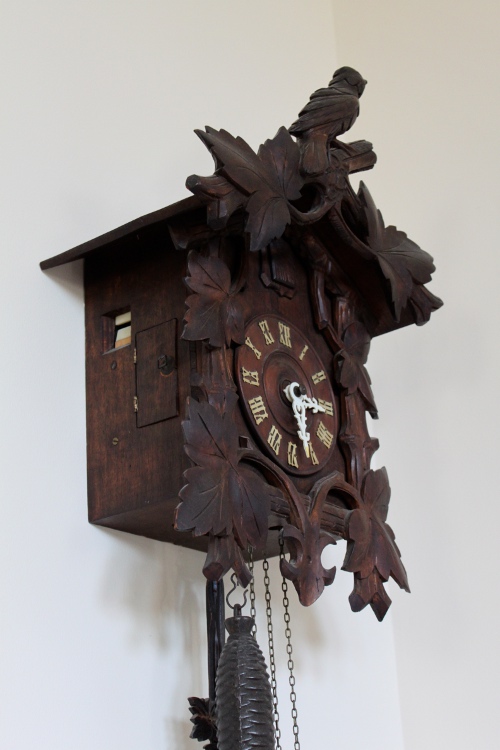
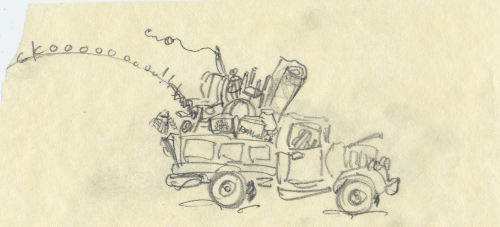
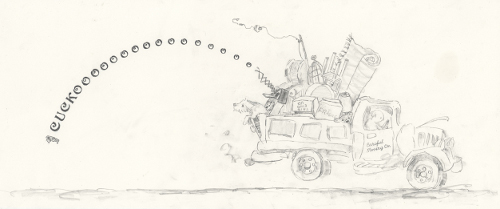
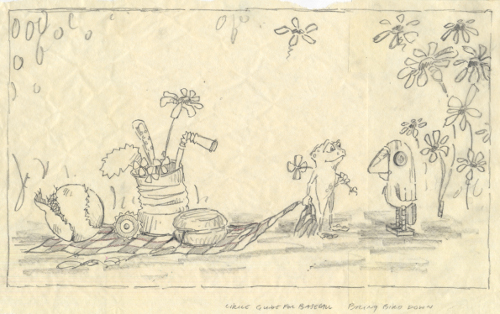
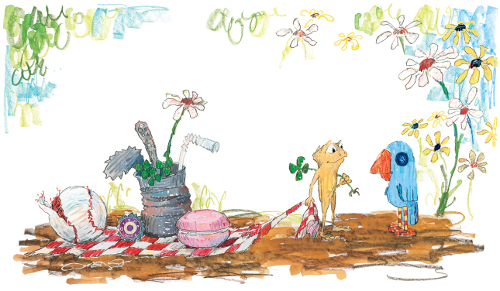


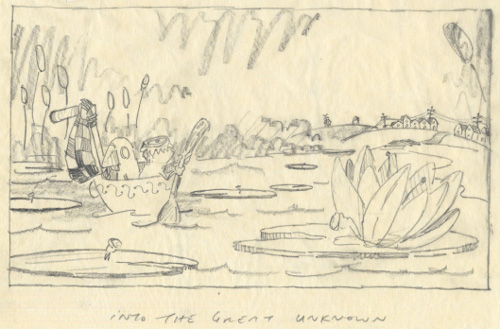
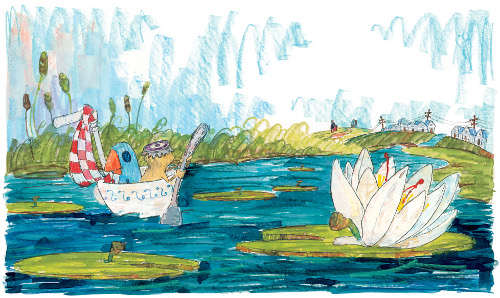
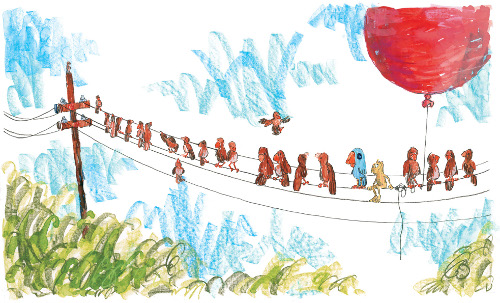
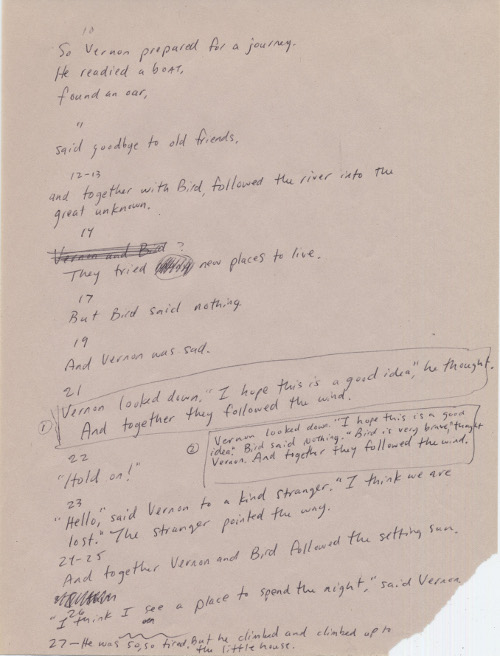
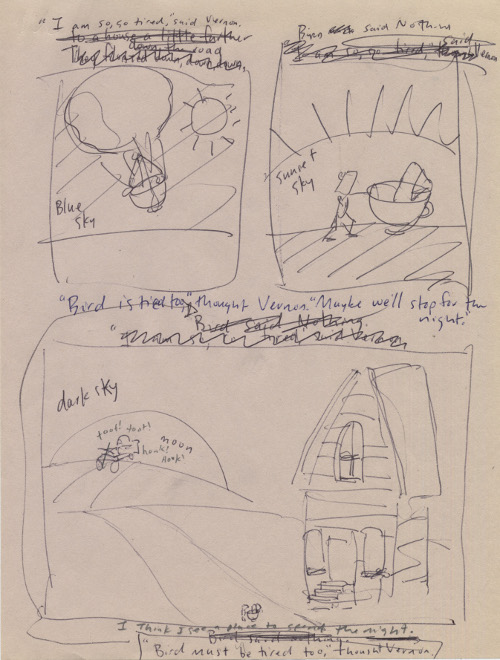


Wow! What a fantastic post! I enjoyed learning about the long process of creating and can’t wait to see the book. I love the detail and character in the drawings…they remind me of Sebastian Menschenmoser (did I spell that right)?The colors are so vibrant…I could go on and on! I wish I could raid the Stead’s trash can for rejected lovlies. Thanks for such a lovely post!
Good grief, the guy can draw. Wonderful interview, wonderful background, wonderful looking book. Can’t wait to lock down a copy! (love that frog…)
I can take no credit for any type of interview, to be clear. I asked him to stop by. He sent me this (including the post’s title, which I had to only slightly adjust). I LOVE IT. Moment of silence for his thoughtful write-up … [Time interlude] … Okay, thanks for indulging me there …
This book is like a good, aged fine wine.
I am in awe of this post. Eye and brain candy galore!. Thank You, Thank you!
Wow! Double Wow! This is the kind of post that I soak up like a sponge, squeeze out and soak up all over again. Like my Mom always said (a hundred or so times) anything worth doing is worth doing right; the evolution of this gem is priceless. I absolutely love the line, “Maybe all the stories I’ll ever write already exist, and it’s just up to me to discover the pieces and put them together.” The art goes straight to your heart. I can not wait to hold this book.
So many things I read above and thought “yes!” Example: “I think the best ideas are willing to stay and wait their turn.” Yes! I have a similar theory about paying attention to the ideas that haunt you.
Philip, Jules,
It is so wonderful to have the full background story of a picture book’s creation. So many times–as I sit critiquing a newbie’s efforts–I hear the refrain, “Well, I thought I’d start with a picture book — because they are easy. Right?” (!) I’m going to send anyone who ever says that to me again directly to this post.
(Okay… yes, there are those times when an author/illustrator reports “It all just came to me in a flash one afternoon.” But that is an extremely rare lightning-strike event and, well, I hate those people — not really hate, but you know what I mean.)
Usually one has to duke it out with a story. And A Home for Bird was one wonderful creative bout!
Thank you for sharing this process. I have many times tried to convey to the children that visit our school library, just how special it would be to give life to a creature through written words and illustrations. How fun it will be to share your story. We anxiously await the finished product to find a home on our shelf!
I heard Philip flip through an ARC copy of this book while touring for another one this spring and fell in love with it. I love all of the back story here. I put a post on my blog about the book and linking through to your blog so that everyone else can read this and fall in love with it as well.
Thanks for sharing, Phillip.
So many nuggets in this post.
I love the story of the story, and I can’t wait to see the book.
I quite agree about endpapers, Jules. Many are illustrated these days, which I often enjoy, or they are just kind of a BLAH color. A rich color always grabs my attention. It sets a tone.
Re: coloring outside the lines, I love in art and music when there are those moments that let us know person made these things. It’s part of the life of a piece, I think.
When creating a great picture book simplicity, cadence and lovable characters are essential.Simple stories can be the hardest to compose but are always the best ones to read to young children. Young children can fall in love with language when a well crafted book is read over and over again to them. . I can hardly wait to read this book to my granddaughter again, and again, and again and….
a work of absolute beauty. Pre-ordered! I love it.. such life in the artwork and the story… I totally agree about polished artwork killing any life and vibrancy it might have had, I have always gone for styles that have character and signature and feeling, which absolutely sums up what his choice of materials brings to the images. BRAVO and well worth all the effort! Love your website!
Great post, Phil – I love getting to see your sketches and process and to know that six years is an O.K. time for a book to come to fruition! I think your initial sketches that inspired the story deserve a second look for another project; maybe just keeping in that style. They are very strong.
Love the interview. The characters are adorable! I even like the not so final pencil sketches. I can’t imagine working on something for so long. Some things take time to ruminate, I suppose book making is one of those things.
So talented! I love the world you two create with your art! I’m Kayrl’s cousin:) Love your work, can’t wait to read your books to my daughter:))
Camille
This post is taking a long time to digest. Truly remarkable.
What an amazing, amazing post. It’s like your brain has been cracked open for us all to peek inside. I’m inspired by the work and perseverance and more work and time that went into making this story. And I can’t wait to read the book!
Great post. Still digesting everything. Can’t wait to read the book.
Just thought I’d add… my pre-ordered book arrived in the post today. I adore the illustrations and the story is fantastic, both complement eachother so well! So often I find either the story or the illustrations flimsy, or one lets the other down for me. Not here – both were equally touching, refreshing and simple (in a good way!!) I’m so inspired by the style and choice of materials too. Bravo.
[…] by Stead of the process he went through in creating this book at one of my favorite ever blogs, Seven Impossible Things Before Breakfast that artists/writers will especially enjoy — or anyone who adores picture […]
Love your illustrations, have posted image of ‘toad sailing in a teacup’ on our page. Hope you approve.
[…] YOU MUST READ THIS POST. Philip reveals the history of this story and what he learned about his storytelling process with […]
This is awe-inspiring…my mouth open the entire time. I can’t wait to read this book. It’s beautiful and yet simple. I loved the storyline and reading Philip’s story behind the story. Thanks so much for sharing!
[…] to an old (well, sorta old) discussion that Mr. Stead shared on the very fun and informative blog Seven Impossible Things Before Breakfast. In this discussion, the author takes us through the process of creating a picture book from the […]
[…] even better is the link I found on Stead’s page to the creative process post he whipped up for Seven Impossible Things Before Breakfast. Here you get the full story of the six […]
Loved it all over again.
[…] out the story behind the story in an interview with Mr. Stead at Seven Impossible Things Before […]
[…] Interview with Stead about the origins of this book. About these ads GA_googleAddAttr(“AdOpt”, “1”); GA_googleAddAttr(“Origin”, “other”); GA_googleAddAttr(“theme_bg”, “7dbaea”); GA_googleAddAttr(“theme_border”, “d8eaf9;”); GA_googleAddAttr(“theme_text”, “111111”); GA_googleAddAttr(“theme_link”, “3c96df”); GA_googleAddAttr(“theme_url”, “3c96df”); GA_googleAddAttr(“LangId”, “1”); GA_googleAddAttr(“Domain”, “kidlitadventures.wordpress.com”); GA_googleAddAttr(“Autotag”, “books”); GA_googleAddAttr(“Autotag”, “entertainment”); GA_googleFillSlot(“wpcom_below_post”); div.wpadvert>div { margin-top: 1em; } Share this:TwitterFacebookLike this:LikeBe the first to like this. […]
[…] The art feels fresh and innocent, all gently handcrafted. If you read Jules Danielson’s interview with Mr. Stead, you will understand the work that went into this seemingly simple book. […]
The backstory is wonderful, and especially useful for teachers to demonstrate that books come from real people and their experiences. I especially love the simple sketch of the balloon against a blue sky – so much story with so few strokes.
[…] psyched to say I’ll soon be illustrating a picture book written by the amazingly multifaceted Philip C. Stead at the hands of picture book guru Neal […]
[…] and something called an “e-reader,” but every time I go to the bookstore and see a new title by Philip and Erin Stead or Jon Klassen or any of these amazing people making amazing books right now, I am […]
[…] You can read Horn Book’s starred review here and learn more about Stead’s creative process at Seven Impossible Things Before Breakfast. […]
[…] texts tend to have no characters or setting, so I get to invent it.) I got some help from Phil (my husband and often co-author, who is also an illustrator), who helped me design much of the […]
[…] him visiting 7-Imp, he sends me these fully-formed pieces on the creation of his books. (See: Last year’s, or even 2011′s.) I can take no credit here. If I ask someone to visit this site, I’m […]
[…] to Special Delivery. Some stories take months, even years to figure out (I’m looking at you, A Home for Bird), but others change very little from the first moment of inspiration on. Special Delivery was in […]
[…] I guess we authors can always do with Vernon’s determination and continue to get that “quiet manuscript” of ours to sing like what Vernon eventually did with Bird :). Incidentally, Philip Stead’s A Sick Day for Amos McGee, which is considered a “quiet book” (a negative term used by publishers when they reject your manuscript – I have a few of those) was the 2011 Caldecott Winner. So hooray for Quiet Books! Read more about Philip Stead’s books here and how he created A Home for Bird in his interview with Seven Impossible Things Before Breakfast over here. […]
[…] (Click to enlarge) Over at BookPage, I reviewed Philip C. Stead’s newest book, Ideas Are All Around, published this month by Neal Porter Books/Roaring Brook Press. […]
[…] The art feels fresh and innocent, all gently handcrafted. If you read Jules Danielson’s interview with Mr. Stead, you will understand the work that went into this seemingly simple book. […]
[…] have a drink with Tomi Ungerer. I would like some of his revolutionary spirit to rub off on me. And Philip and Erin Stead! They are also printmaker-illustrators and fellow Michiganders. Hey, maybe I will […]